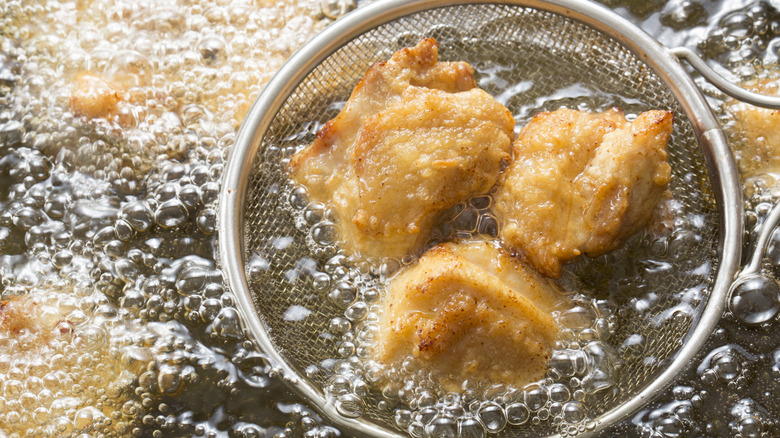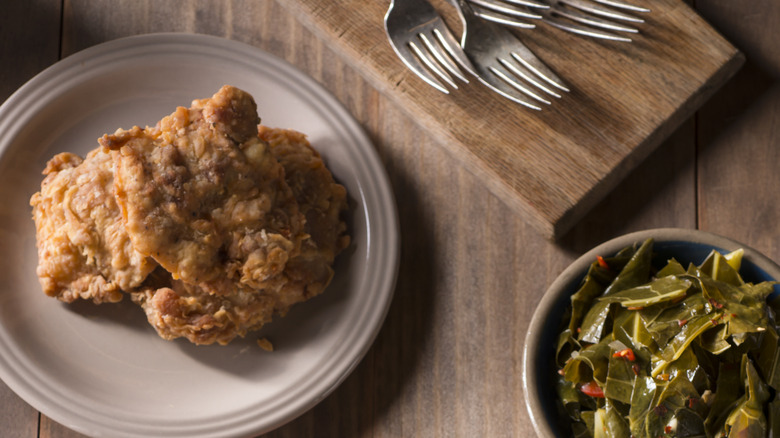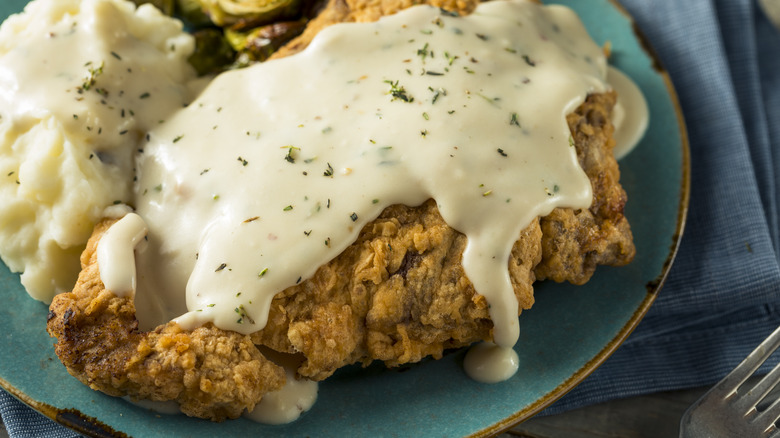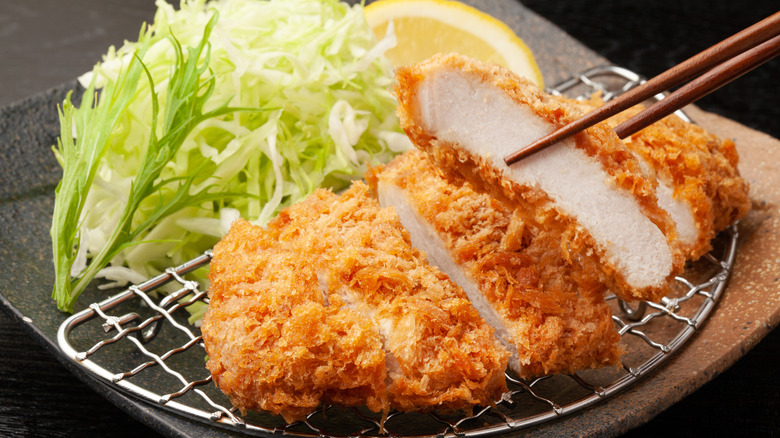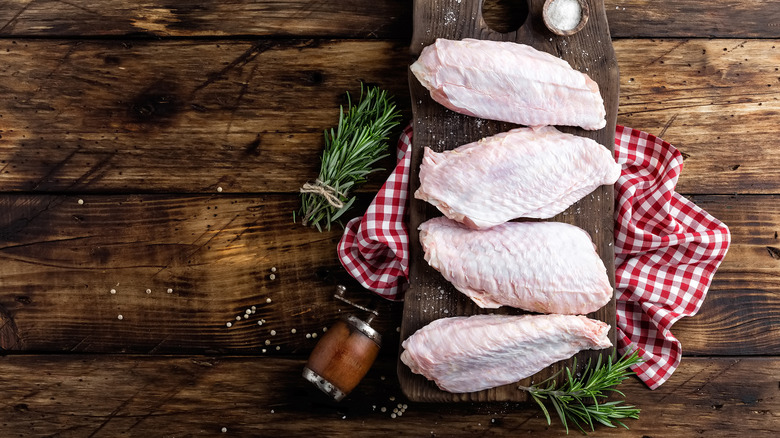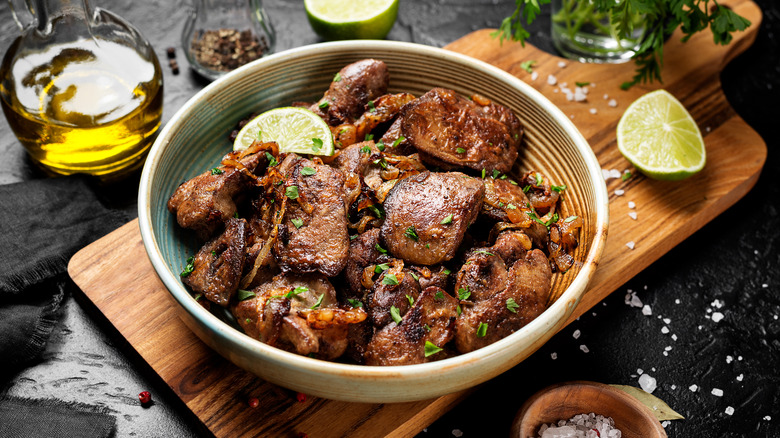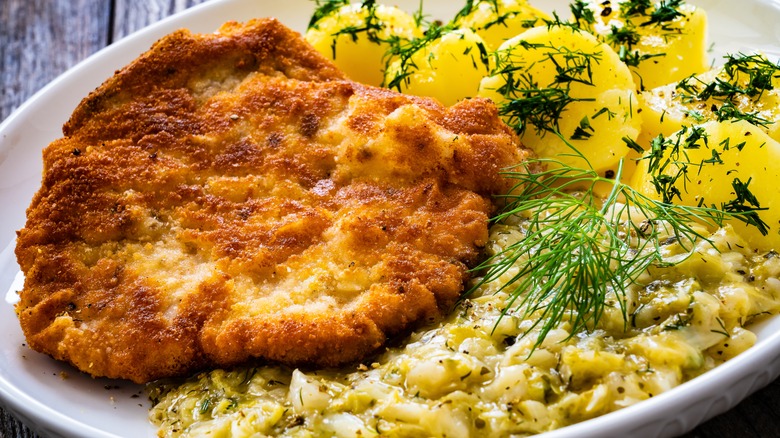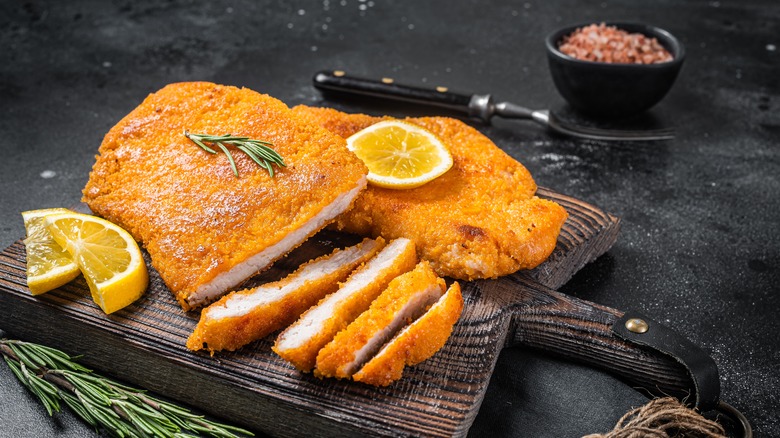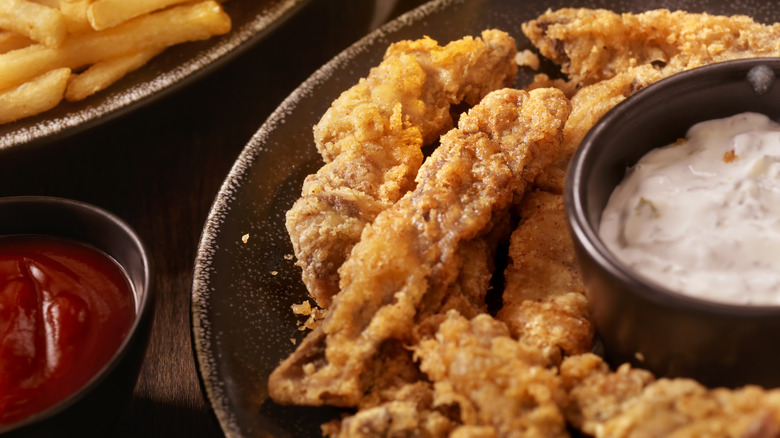8 Absolute Best Cuts Of Meat To Deep Fry
There's something profoundly comforting about deep-fried foods. Whether it's the nostalgia of childhood county fairs or the anticipation tied to a basket of game-day chicken wings, there's no denying the magic deep frying imparts on even the simplest dishes.
There's really no secret to the cooking method: When oil reaches a high enough temperature, it causes the food's surface to cook instantly, creating a seal in the form of a signature golden crust that keeps the fat out and moisture locked in. That moisture converts to steam, cooking from the inside out. The result? A juicy, perfectly cooked morsel encapsulated in a crispy shell of deliciousness.
Deep fat frying works well on any number of dishes, but it's particularly effective for cooking meat thanks to that crispy moisture-locking seal. Lean meats and cheaper cuts especially benefit from a dip in the deep fryer — or a Dutch oven in the case of most home cooks. Where more direct-heat methods like pan-frying or grilling can cause precious fat loss, deep frying keeps all the good stuff in the meat resulting in a deliciously moist bite.
Still nervous about cooking with all that hot oil? Don't be. While there are certain mistakes to avoid when deep frying, a little preparation and the correct cooking vessel are really all you need to transform cheaper cuts of meat into crispy golden deliciousness.
Chicken thighs
When it comes to deep-fried foods, few bites hit the spot like old-fashioned fried chicken. While the restaurant variety can be hit or miss, making the classic comfort food staple at home can be a slam dunk with a few tips and tricks. Among the secrets to making great fried chicken is to use dark meat.
Chicken thighs specifically work wonders in the deep fryer. With plenty of surface area for all that crispy crust but not so large that they take ages to cook (here's looking at you, chicken breast), the dark meat delights provide the perfect crunch-to-juicy-protein ratio. And thanks to higher fat content, even boneless, skinless thighs retain a mouthwatering amount of moisture after a dunk in the deep fryer.
While chicken thighs may take top billing, chicken legs earn an honorable mention for their similarly high-fat content and signature shape. Just be sure to separate the legs from the thighs before frying — whole leg quarters will take too long to deep fry and are likely to dry out.
To maximize their flavor, try brining chicken thighs in pickle juice or buttermilk prior to frying. Give other flavor-enhancing tricks a shot, like basting the chicken in mustard before breading, or tossing the finished product in a cayenne-butter mixture for a homemade take on Nashville hot chicken.
Cube steaks
The beefy goodness behind diner-favorite chicken-fried steak, cube steaks are tender, thin, and boast plenty of surface area to collect crispy goodness in the deep fryer. But what exactly are cube steaks? The term itself comes from the square-shaped indentations left behind by a mechanical meat tenderizer, a process that can transform almost any super-lean cut into a quick-cooking timesaver. Cube steaks are typically cut from the beef round or beef chuck, both traditionally tough portions used for low and slow applications like stews. But thanks to some tough love, these beefy bites are destined for something just as comforting.
Any potential downsides to the so-called "minute steak" can be mitigated by deep frying. Where the ultra-lean cut can dry out quickly when exposed to direct heat, deep frying helps seal in moisture so it stays juicy. All those unsightly little nooks and crannies left behind by the tenderization process make cube steaks ideal for absorbing flavor — in this case, a crispy, crunchy crust. Served with peppery white gravy, chicken-fried steak is easily elevated to a comfort food classic.
But what about country-fried steak? While both are tasty Southern staples, there are minute differences between the two fried steaks. Where chicken-fried steak is extra crispy and served with a white gravy, country-fried steak is double-dredged in seasoned flour and bathed in a rich brown gravy, resulting in a less crunchy, but deliciously tender bite.
Pork loin
Despite being one of the most common cuts found at the butcher counter, pork loin gets a bad rap as a dry and flavorless piece of the pig. Thanks to its location along the pig's back, the cut remains fairly lean, but unlike the similarly placed pork tenderloin, the loin benefits from a small fat cap that keeps the meat moist whether it's cooked low and slow or deliciously deep fried.
Pork loin's versatility makes it an ideal guinea pig with which to experiment in the kitchen. If you plan to go the deep fry route (which you should), try your hand at deliciously crispy pork loin tonkatsu. This Japanese delight is simple to whip up on a weeknight, especially once you get the hang of the technique, and is a perfect meal prep protein. Pair the deep-fried cutlets with rice and a quick slaw or stuff them between slices of Japanese milk bread for grab-and-go lunches you won't dread when your stomach starts to rumble.
The secret to rosu katsu's super crispy exterior is two-fold: panko breadcrumb crust and a double dip in the deep fryer. Panko absorbs less oil than finer store-bought breadcrumbs, so it can withstand the double fry while still delivering a lighter, crunchier coating. So why the double dip? The rest time in between dunks in the hot oil helps the pork to reach the ideal internal temperature without overcooking the exterior. That second fry is what gives you that satisfying golden brown crunch.
Turkey wings
Move over chicken wings, there's a new bird in town. More richly flavored than their poultry cousins, turkey wings are a tasty (and impressive) upgrade to your typical game-day spread. Treat them just as you would chicken wings, deep frying and tossing them in buffalo sauce or spicing things up with a blend of Cajun seasonings. Turkey wings may take a few more minutes to cook, but the juicy results are well worth the wait.
Typically thought of only as a Thanksgiving centerpiece or a lunchtime staple, the turkey might just be more American than apple pie, especially when deep-fried. While there are certainly flavorful benefits to the Thanksgiving day practice, deep frying a whole bird (especially over a certain weight limit) can be downright dangerous. According to the National Fire Protection Association, Thanksgiving sees three times more house fires than any other day of the year, many of which are started by improperly fried turkeys.
While the holiday centerpiece is best roasted in the oven, those craving a bite of deep-fried bird can opt for a deconstructed approach. Frying turkey parts is significantly safer and simpler due to a reduced surface area and less cooking time, but it still reaps all the tasty benefits of a dip in the deep fryer. And the best part? Most grocery stores sell the pre-butchered birds for a discount in the days following Thanksgiving.
Chicken livers
Feel good (well, better) about eating deep-fried fare when you whip up a batch of crispy chicken livers. One of the most nutrient-dense foods out there, chicken livers pack plenty of protein, iron, and Vitamins A, B, and C into one tasty little package, made even more delicious with a crisp, golden crust.
One of the biggest complaints against liver is its metallic flavor; which is hardly surprising, since the liver's main function is to filter blood. Luckily, there are plenty of simple ways to mitigate those unsavory attributes. First and foremost, give those livers a buttermilk bath. The acidic nature of the milk not only neutralizes the liver's metallic taste but also removes impurities and acts as a tenderizer, ensuring the most delicious possible bite.
Once those chicken livers are thoroughly soaked, give them a double dredge in seasoned flour and panko breadcrumbs. The double dip helps to guarantee an extra crispy coating so your livers taste a bit more like grown-up chicken nuggets. A quick fry ensures a crunchy exterior and a moist, almost creamy interior.
Of course, all the kitchen tips and tricks in the world won't hide the impurities of a sub-par product. When choosing chicken livers to fry, be on the lookout for their color. Those just venturing into the world of offal should look for a pale, cream-colored specimen, a surefire sign of a fattier, more mild-tasting liver. Dark red livers tend to taste a bit more like organ meat — not necessarily a bad thing, especially for carnivorous connoisseurs.
Pork chops
It's no secret that pork chops can be unbearably boring. But the surprising truth is that their simplicity is their strength. Lean, affordable, and easy to come by, pork chops and their sponge-like tendency to absorb flavor make them an ideal candidate for the deep fryer.
One of the easiest ways to add more flavor to your fried pork chops is to experiment with your breading. Use dried herbs to spice up a crispy crust or mix in some shredded coconut for a tropical twist on classic pork chops. But if you have a little more time on your hands, the best way to prepare pork chops for the deep fryer is with brine.
While "brining" may sound like a terrifying term relegated to professional kitchens or reserved for Thanksgiving turkeys, the process is really quite simple. To brine pork chops is to impart flavor and moisture into the protein using salt — either through a saltwater solution flavored with aromatics or simply by rubbing coarse salt directly onto the meat. The only question is whether to go the wet or dry brine route.
When it comes to deep frying, drier is better to avoid the dreaded (and dangerous) oil splatter. To dry brine your pork chops, simply rub them liberally with coarse salt, ground pepper, and any other dried herbs you desire. Let them rest in the fridge for between eight and 24 hours before breading and deep frying for the juicy, crispy bite of your pork-loving dreams.
Veal cutlets
A bit of beef all but unknown to the average home cook, veal combines the richness of red meat with the leaner attributes of pork chops for a tender, juicy bite unlike almost any other protein. Thanks to a lack of tough muscles and a small amount of fat, veal is fairly forgiving in the kitchen, making its chops and cutlets perfect cuts for beginners to experiment with. And when it comes to deep frying the prized meat, there's no better dish to try than wiener schnitzel.
As emblematic to Austria as fried chicken is to the Southern U.S., wiener schnitzel is as simple as it is flavorful: A thinly pounded veal cut dredged in flour, dipped in egg, tossed in bread crumbs, and fried. While the dish is traditionally pan-fried, the deep-fried version is just as (if not more) delicious. Of course, you could substitute the veal cutlet for chicken or pork, but then it wouldn't be wiener schnitzel. In Austria, the term can legally only be applied to a breaded veal cutlet and anything else must be labeled as simply "schnitzel."
Austrians are serious about their wiener schnitzel and it's easy to see why — especially once you whip it up yourself in your home kitchen. Crispy golden brown on the outside and juicy on the inside, the classic deep-fried veal cutlet might just become your new weeknight dinner slump-breaker.
Sirloin steak
While some may like their steaks served sizzling from the grill, those in the Northwestern U.S. prefer their beef a little crispier. Deep fried to golden brown perfection, finger steaks have been a staple bar food in Idaho for more than half a century. Legend has it that two competing Idaho restaurants started frying up finger steaks in the 1950s and locals have been hooked ever since.
One of the original versions of the dish featured repurposed steak trimmings as its core protein (also an option for those who butcher their beef at home), but today's varieties typically use the slightly more elevated sirloin. Fairly cheap and easy to find, sirloin steaks fry up nicely — think crispy crust and tender, juicy interior — and hold their shape well thanks to lean muscular makeup.
When it comes to making finger steaks at home, the key is to cut the beef into that signature finger shape, or two to three-inch strips. Soak the steak strips in a marinade of buttermilk, Worcestershire sauce, salt, pepper, garlic powder, dry mustard, and paprika for a few hours before dredging in seasoned flour, dipping in the leftover buttermilk mixture, and deep frying to crisp, juicy perfection. Be sure to serve the deep-fried finger steaks Idaho-style with homemade fry sauce.
